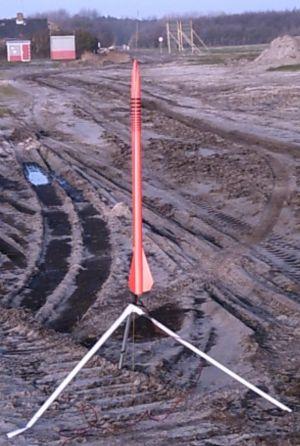| Construction Rating: | starstarstarstarstar_border |
| Flight Rating: | starstarstarstarstar_border |
| Overall Rating: | starstarstarstarstar_border |
| Manufacturer: | Caveman Rocketry  |

Brief:
Single stage mid power rocket with parachute recovery.
Construction:
The kit contains:
- 2 cardboard body tubes
- 3 plywood fins (1mm thick)
- 2 plywood centering rings
- cardboard motor mount tube 24mm x 10 inches long
- Kevlar shock cord, 40 inches long
- cardboard thrust ring
- plastic nose cone
- 18 inch rip stop nylon parachute
- launch lug
With simple and straightforward instructions, the kit is easy to construct since there are not that many parts.
The construction starts with the motor mount and shock cord attachment. A small hole needs to be drilled in the upper centering ring. The shock cord must have a tight fit into that hole and be secured with a drop of epoxy. There is no engine hook included so I made one from a large paperclip and attached it with 5 min epoxy through a hole in the rear centering ring. The motor mount and the centering rings fit well.
The 1mm thick fins were warped so straightened them in a jet of steam from a kettle. Caveman told me that the latest kits are provided with thicker fins to avoid warping. The fins fit well into the slots. First smear some 5 min epoxy along the fin root and put it in the slot against the motor mount. Don't use white glue for the fins might get warped again. When the epoxy is set and the fins are well positioned, apply fin fillets along the fins with epoxy. Glue the coupler into a body tube. You can decide to use the upper body tube as a payload section, otherwise, just glue the tubes together.

Finishing:
For finishing I used epoxy based wood filler first. I applied putty along the spiral groove and the part where the upper and lower body tubes were glued together. After sanding, I sprayed a thick layer of spray putty all over the rocket. The spray putty was sanded with fine waterproof sandpaper which provides a smooth surface for painting.
I painted mine over all fluorescent red-orange because I lost 2 Magnum Opi before.
After painting you can apply the striped decal. The decal is a bit too small to fit all around the rocket but with a bit of stretching it barely fits.
Construction Rating: 4 out of 5
Flight:
Caveman says the rocket is light enough for flights on an Estes C engine and strong enough to withstand the power of an E30 engine. The first two flights I launched the Magnum Opus on an Estes E9-8. Beautiful, long, and straight boosts that coasted up to about 2000ft. When I ran out of the E9-8s I decided to launch it on an AeroTech F24-7. That motor gave the rocket a fast and straight boost up to 2600ft, but the 7 second delay is a bit too short. No zippers or other damage occurred though.
 The Magnum Opus really goes lightning fast on an AT F39-9T Blue Thunder. It can withstand even the power of that motor! I watched a few flights when it spun violently just before motor burn out. I suspect the rocket encountered shockwaves near the transonic region, so it shouldn't go any faster! An F39 with a 9 second delay pushes the rocket up to 3000ft so you better launch it with that motor only on calm days.
The Magnum Opus really goes lightning fast on an AT F39-9T Blue Thunder. It can withstand even the power of that motor! I watched a few flights when it spun violently just before motor burn out. I suspect the rocket encountered shockwaves near the transonic region, so it shouldn't go any faster! An F39 with a 9 second delay pushes the rocket up to 3000ft so you better launch it with that motor only on calm days.
Preparation is simple: just put some crepe paper wadding into the body tube. For high altitude tracking, I also apply a fair amount of talc powder on top of the wadding.
For motor retention I use both friction fit and engine hooks made from large paperclips. I never lost a casing with these precautions.
Recovery:
The kit provides a Kevlar shock cord and 18 inch rip stop parachute. I found the Kevlar cord to be a bit short so I tied a piece of elastic to the shock cord. The rocket only weighs about 200 grams so the 18 inch parachute might prove to be a little big. The Magnum Opus takes it's time descending from 2800ft! Under windy conditions and/or small fields a smaller parachute (about 12 inch) or even a streamer would be more appropriate.
Flight Rating: 4 out of 5
Summary:
The rocket stands about 3ft tall and is a real eye catcher. As Caveman says, "it's long, lean, and mean." It flies on a wide range of motors, from D (or even C) up to an F39. The rocket is light and strong, simple to construct, and great fun to fly. It really punches a hole in the sky on relatively small motors. The rocket always flew stable, no trimming or extra weights were needed.
The cons are the warped fins but that problem would be solved by the newer kits with slightly thicker fins. There is no (mechanical) motor retention so you have to make something yourself if you don't want to lose a motor casing. The parachute is high quality but its size is a bit too big for such a light rocket.
In all I think that the Magnum Opus truly is a masterpiece.
Overall Rating: 4 out of 5
Sponsored Ads
 |
 |











